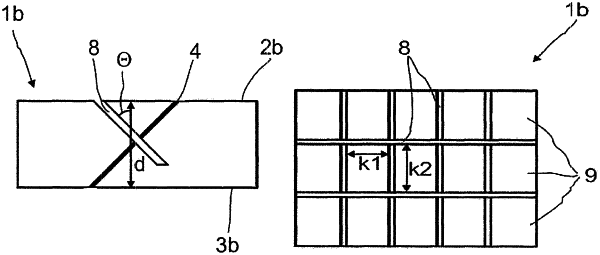|
1. A process for converting a molding comprising the following steps a) and b):a) providing a molding comprising a foam and at least one fiber (F), wherein the fiber (F) is with a fiber region (FB2) located inside the molding and surrounded by the foam, b) at least partially dividing the molding at least once, wherein at least one fiber (F) is completely divided to obtain a converted molding, wherein in step a) the molding is provided when at least one fiber (F) is partially introduced into the foam with a result that the fiber (F) is with the fiber region (FB2) located inside the molding and surrounded by the foam while a fiber region (FBI) of the fiber (F) projects from a first side of the molding and a fiber region (FB3) of the fiber (F) projects from a second side of the molding and the fiber region (FB1) and/or the fiber region (FB3) are then optionally removed, wherein partial introduction is optionally effected by steps a1) to a6): a1) optionally applying at least one layer (S2) and optionally applying at least one carrier layer (TS) to at least one side of the foam, a2) producing one hole per fiber (F) in the foam and optionally in the layer (S2) and optionally in the carrier layer (TS), wherein the hole extends from a first side to a second side of the foam and optionally through the layer (S2) and optionally through the carrier layer (TS), a3) providing at least one fiber (F) on the second side of the foam, a4) passing a needle from the first side of the foam through the hole to the second side of the foam and optionally passing the needle through the layer (S2) and optionally passing the needle through the carrier layer (TS), a5) securing at least one fiber (F) to the needle on the second side of the foam and a6) returning the needle along with the fiber (F) through the hole, so that the fiber (F) is with the fiber region (FB2) located inside the molding and surrounded by the foam while the fiber region (FB1) of the fiber (F) projects from a first side of the molding or optionally from the layer (S2) or optionally from the carrier layer (TS) and the fiber region (FB3) of the fiber (F) projects from a second side of the molding, wherein the at least partial dividing of the molding in step b) is effected with a cutting tool wherein the at least partial dividing of the molding in step b) is effected without material removal-, wherein the fiber region (FB 1) and the fiber region (FB3) each independently of one another account for 0.1% to 45% and the fiber region (FB2) accounts for 10% to 99.8% of the total length of a fiber (F) in step a).
|
